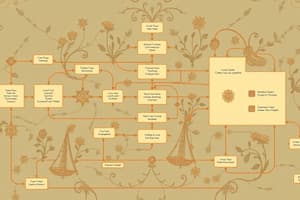Podcast
Questions and Answers
What is a process model?
What is a process model?
A graphical representation of business processes showing activities and data movement.
Which of the following is a commonly used process modeling technique?
Which of the following is a commonly used process modeling technique?
- Class Diagrams
- Entity Relationship Diagrams
- Data Flow Diagramming (correct)
- Use Case Diagrams
What does a data flow diagram primarily focus on?
What does a data flow diagram primarily focus on?
- Implementation details
- Data organization
- User interface design
- Activities that are performed (correct)
A data flow diagram can document both as-is and to-be systems.
A data flow diagram can document both as-is and to-be systems.
What is the focus of logical process models?
What is the focus of logical process models?
What is the benefit of using process models?
What is the benefit of using process models?
Which activity does NOT relate to creating data flow diagrams?
Which activity does NOT relate to creating data flow diagrams?
Match the following process modeling terms with their definitions:
Match the following process modeling terms with their definitions:
What is critical when informing management?
What is critical when informing management?
Which of the following is NOT a technique for collecting business requirements?
Which of the following is NOT a technique for collecting business requirements?
The problem definition only refers to areas that have something seriously wrong with them.
The problem definition only refers to areas that have something seriously wrong with them.
What should be defined to avoid wasting time on previously researched topics?
What should be defined to avoid wasting time on previously researched topics?
A stakeholder is a _____ person in the project.
A stakeholder is a _____ person in the project.
Which statement is true about stakeholders?
Which statement is true about stakeholders?
What is the first step to understanding stakeholder requirements?
What is the first step to understanding stakeholder requirements?
Flashcards are hidden until you start studying
Study Notes
Introduction
- Process models are a type of visual representation depicting how a business system works.
- Process models can be used to document both the current system (as-is) and the new system (to-be) being developed, regardless of whether the system is computerized or manual.
- Process models have been a key tool in structured systems analysis and design for many years, but their usage has decreased with the rise of use cases.
- Use cases can provide a sufficient understanding of the system being developed for some organizations, while other organizations find process modeling to be a valuable complement to their analysis phase.
- Process models help analysts gain a clear understanding of the system's functionalities before construction.
- The chapter focuses on data flow diagramming (DFD) as a popular process modeling technique.
- DFDs visually represent business processes and the flow of data among them.
- Although DFDs imply a focus on data, the primary emphasis is on the processes or activities performed.
- Process modeling, particularly DFD creation, is a crucial skill for systems analysts.
- The text focuses on logical process models, which describe processes without specifying how they are executed.
- Logical process models do not reveal whether a process is automated or manual, how data is collected, or where data is stored.
- These physical details are addressed during the design phase when logical models are transformed into physical models.
- By initially focusing on logical processes, analysts can concentrate on the desired functioning of the business without being distracted by implementation details.
Data Flow Diagrams
- Figure 5-1 presents a DFD that visualizes the process of a Lawn Chemical Applicator (LCA) requesting a lawn chemical.
Stakeholder Management
- It's crucial to inform management about the project and its impact on their departments.
- When interacting with decision-makers, be mindful of their perspective and how the project can benefit them.
- During project initiation, identify key stakeholders, create a scope statement and define completion criteria.
- Remember to treat everyone as critical to the project, regardless of their position.
Collecting Business Requirements
- Defining a problem doesn't necessarily mean there's something wrong; it could represent an opportunity for improvement.
- Use diverse collection techniques like interviews, job observation, and literature reviews.
- Literature reviews include analyzing books, research papers, and other relevant materials to avoid repeating previous research.
- System reviews involve collecting information from various sources like websites, intranet sites, and company documents.
- Identify overlapping areas for improvement across different departments.
Requirements Gathering
- Understand the project scope from the project manager and sponsor.
- Be mindful of areas outside the scope of the project during stakeholder conversations.
- Offer alternative solutions when a stakeholder cannot make a decision.
- Different requirements gathering methods include:
- Interviews
- Brainstorming Sessions
- Focus Groups
- Job Observation
- Surveys
- Requirements Gathering Workshops
Requirement Analysis
- Ensure a shared understanding during workshops of the project's vision, goals, objectives, and high-level scope.
- Missing requirements late in the project can lead to rework and modifications.
- Accurate business requirement analysis saves rework and involves:
- Analyzing
- Summarizing
- Documenting requirements
Identifying Stakeholders
- A stakeholder is someone who has something to gain or lose from the project, is impacted by the work, or can influence it.
- It's crucial to know what their requirements and interests are.
- In some cases, all users are stakeholders, but due to their large number, a sample group can represent them.
Studying That Suits You
Use AI to generate personalized quizzes and flashcards to suit your learning preferences.



